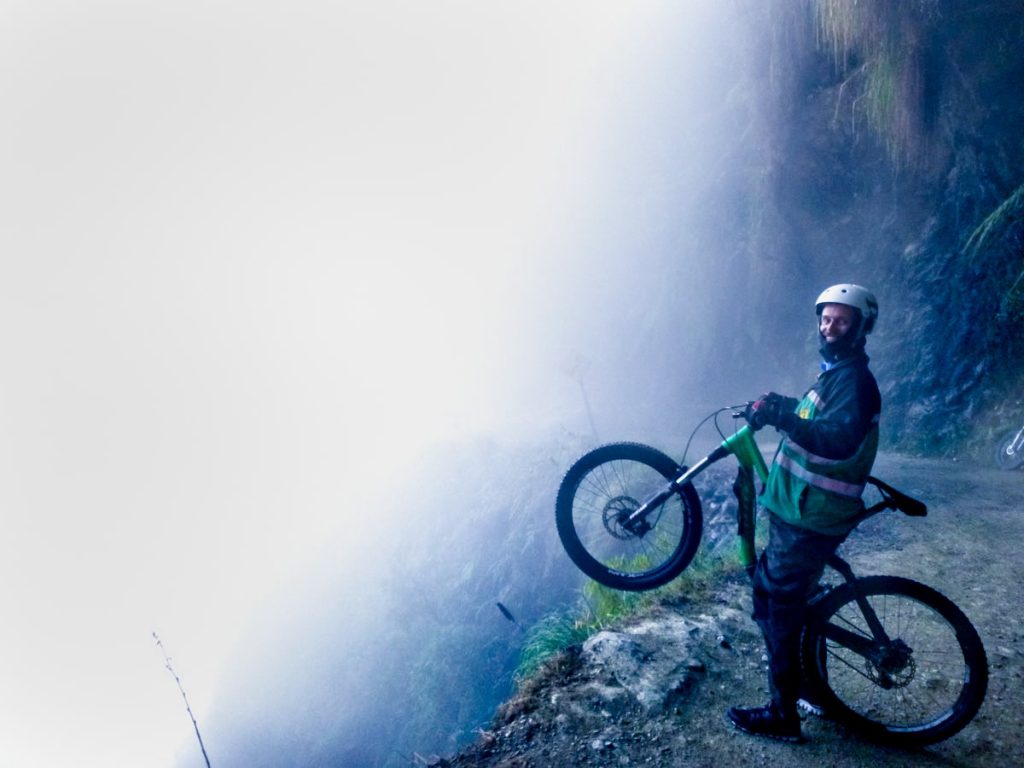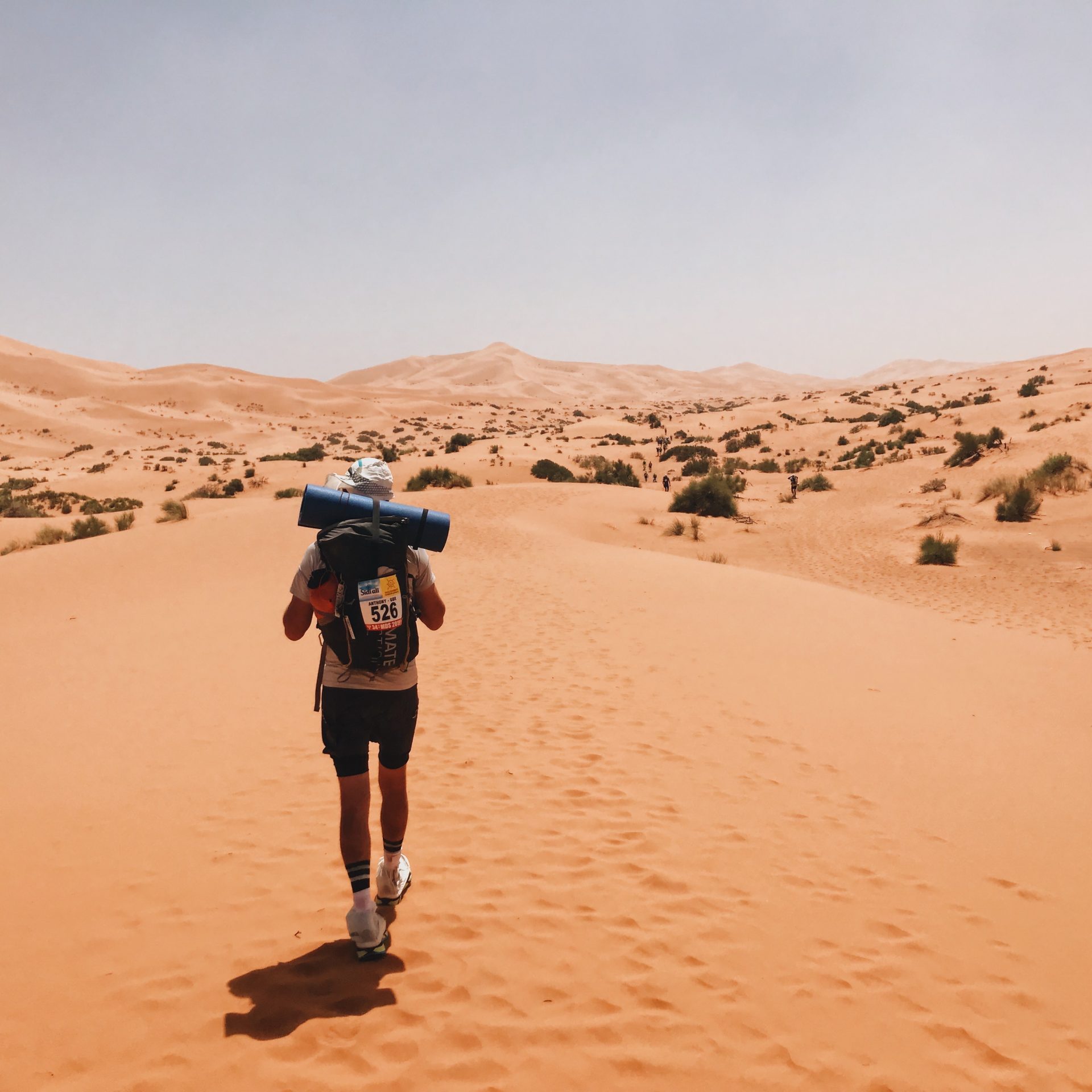Cycling down Bolivia’s Death Road on a cold, wet and foggy day might not be everyone’s cup of tea, but if it is yours… then read on!
The Death Road of Bolivia, (also known as Yungas Road) undoubtedly lives up to its sinister name, taking the lives of several locals and a handful of tourists who dared to venture down it over the years.
It’s also constantly referred to as “The World’s Most Dangerous Road.”
For those who want to cycle down this infamous trail and come back in one piece; by the end of this post, you’ll be confident about what to experience, how to prepare for it and how to stay alive while cycling Bolivia’s Death Road.
What is The Death Toll of The World’s Most Dangerous Road?
The Bolivia death road has an astonishing estimated body count of 200-300 deaths for a forty-year period due to the following factors:
- A 10-foot narrow road
- Hairpin turns (wicked, wild angled bends)
- Rain, fog, & limited visibility
- Rockfalls
- A lack of guardrails
- Cliffs with a 2,000-foot drop
One of the worst accidents occurred in 1983 when a bus carrying over 100 people plummeted off the exposed side of the road.
In 2006, a modernised, safer road was completed, which motorists prefer to use, but there is still traffic on the road that you will be cycling down, the one with the dark history behind its menacing mist.
While these improvements have curbed deaths, they have not eliminated them completely as local workers, tour operators, and backpackers still use the road and since 1998, 18 tourists have died cycling down Bolivia’s death road.
Tourism has increased from roughly 25,000 to 60,000 people per year due to tour operators taking advantage of this boastful bucket list item, I will go into the details of finding a reputable company in this article.
Cycling Bolivia’s Death Road: What To Expect (My Experience)
With very few safeguards and a decent probability of mishaps or even death, why would anyone want to hop on a mountain bike and cycle down this wet and windy, infamous Bolivian death trap?
For glory, of course.
While I am being semi-facetious, I will assume that dying before your time is not a preference of yours and that you have a curiousness about what to expect while cycling down the death road of Bolivia, so here’s how the day went for me from start to finish.
Expect An Early Morning Start
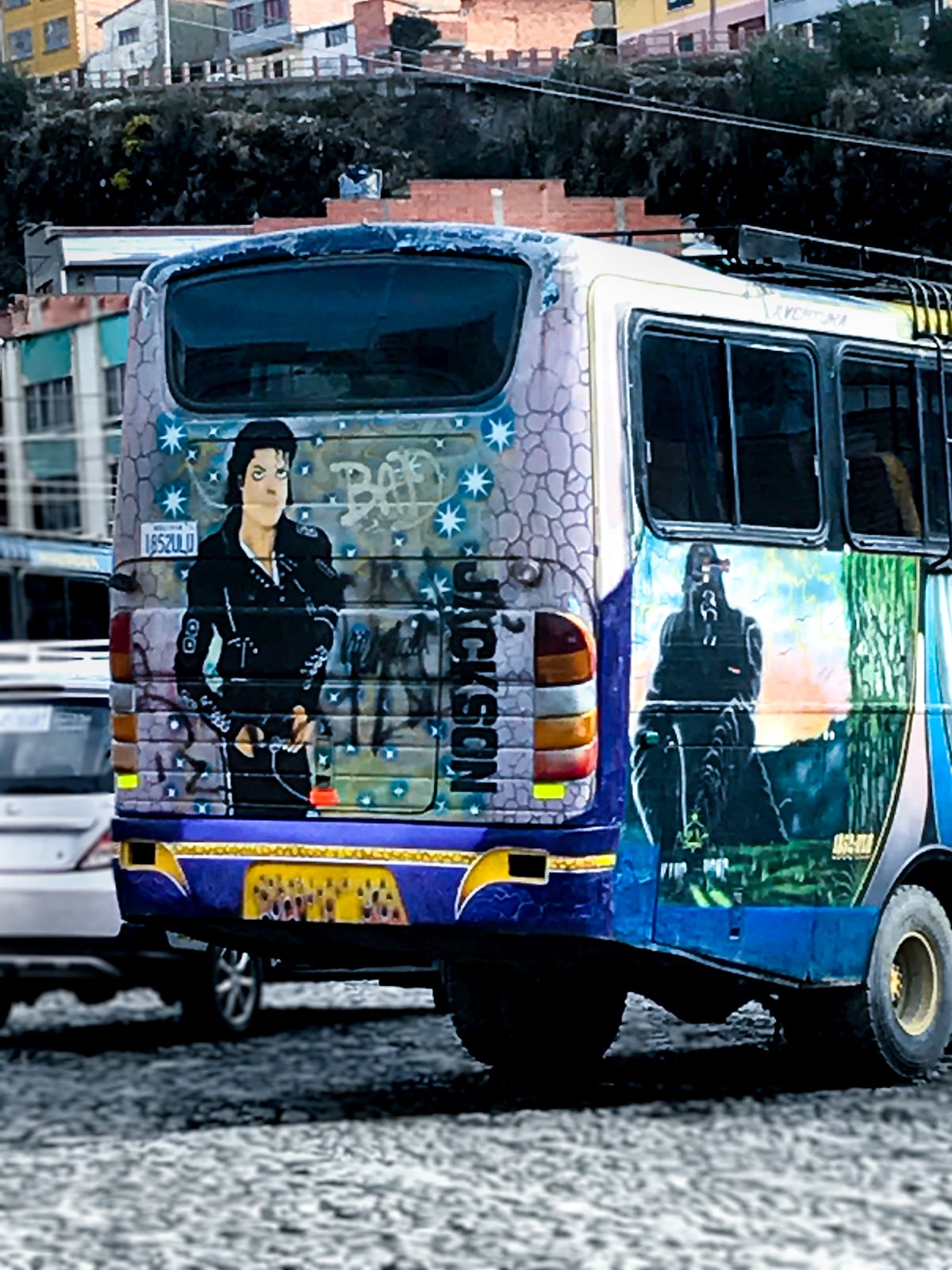
Bad news for adrenaline junkies who also hate mornings (holds hands up); I was picked up at 7 am from my hotel by the tour company’s minivan.
I also wasn’t the first in, so expect to be ready to go very early in the morning for the great battle of Yungas Road. I already had breakfast but the tour brought a packed lunch for the day and I gratefully accepted.
The guide on the bus asked who was the vegan option, thankfully another guy, a friendly Polish gentleman, put his hand up too and I wasn’t the only one. Hallelujah! I hate being the only one.
The short briefing started in Spanish and although at the time mine was a decent level (thanks to living in Medellin and also being an expat in Santa Marta) my morning brain was more than happy as he re-explained in English.
For the remainder of the two-hour journey, the music playlist on the bus was a ‘danger’ theme to amp us up for the Death Road cycle, with cheesy classics such as “Danger Zone,” It’s My Life,” and “Highway to Hell” (the latter tune triggering traumatic memories from my Marathon des Sables experience).
You will be driving down a steep 2000-foot cliff with no barriers for 3 hours, so get a nice bit of shut-eye the night before in La Paz!
Important Info About Gear (& Mountain Bikes)
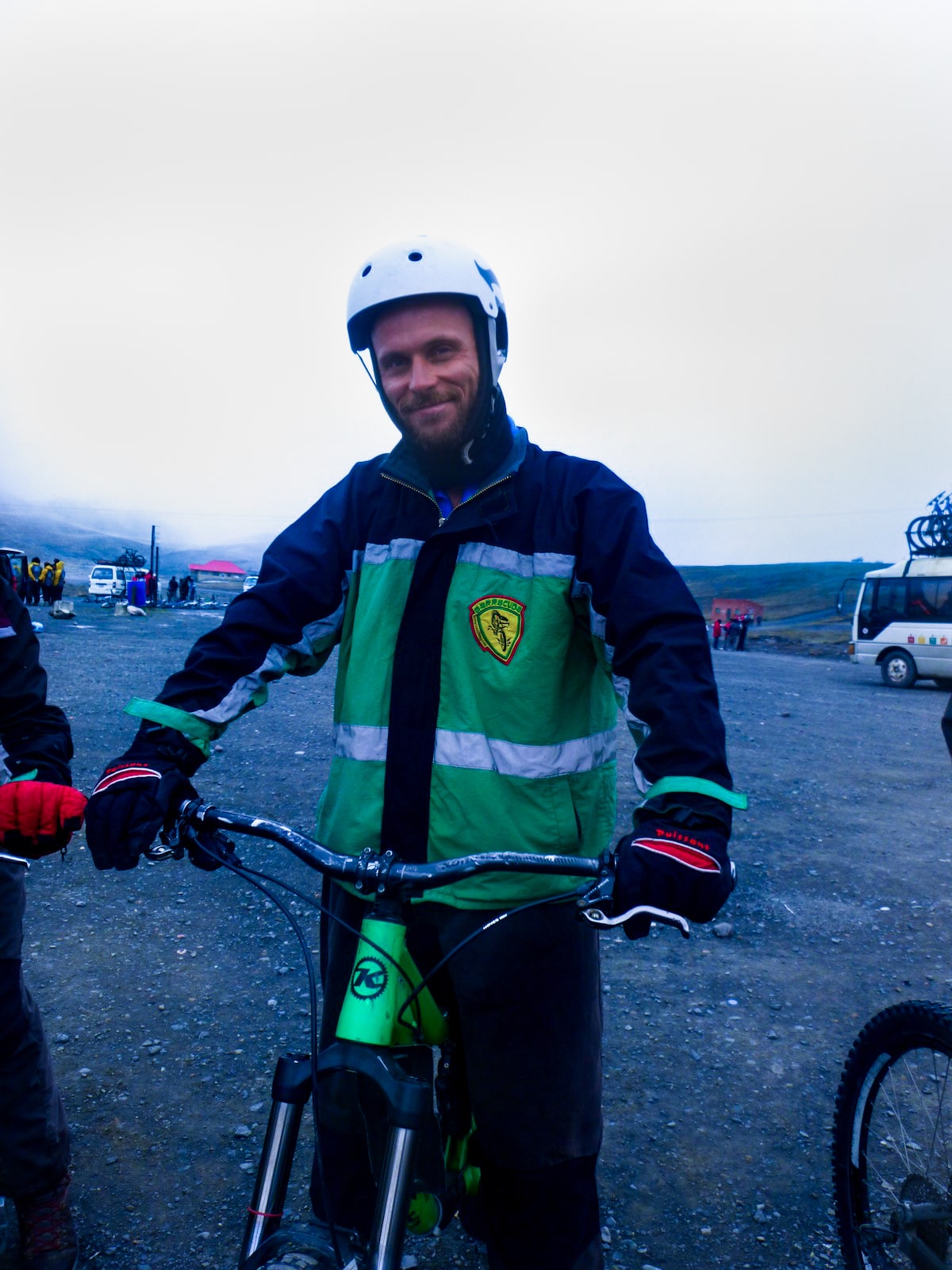
The tour operators provided us with well-fitting helmets, gloves, jackets with fitted elbow pads and trousers with fitted knee pads and what I liked was they seemed very keen to make sure that every individual got the right fit for their bodies.
I can’t imagine how more difficult (or dangerous) the ride would have been if I had clothes that were too tight, or too baggy.
A very important note that I was not aware of myself is about the mountain bikes. I always assumed that bikes all over the world had the back brake on the left-hand side and the front brake on the right, just like back home in the UK.
But it turns out it’s different depending on individual countries and in Bolivia, it was the other way around. (I live in Chiang Mai now and have discovered that the bike breaks over there are the same as they are in Bolivia and South America in general).
It felt instantly weird to me but luckily the guide changed it to what my muscle memory was used to.
I’d hate to have to learn a whole new way of braking while cycling down the World’s most dangerous road!
Team Photo at 4,670 Metres (Higher Than Mt Fuji!)

We posed for our first of many team photos on our mountain bikes, at La Cumbre, the highest point of the Cordillera Oriental Mountains chain; an absolutely whopping 4,670 metres (15,320 feet).
For perspective, I climbed the highest mountain in Japan, Mount Fuji a few years ago, which at 3,776 metres is dwarfed by our starting point here by 894 metres.
While this may sound like a tenuous link to those who have never been to such levels of altitude, this does add to the intensity of the physical activity as you will be short of breath much faster than you would be closer to ground level.
Superstitious Alcohol Shot To Calm The Nerves
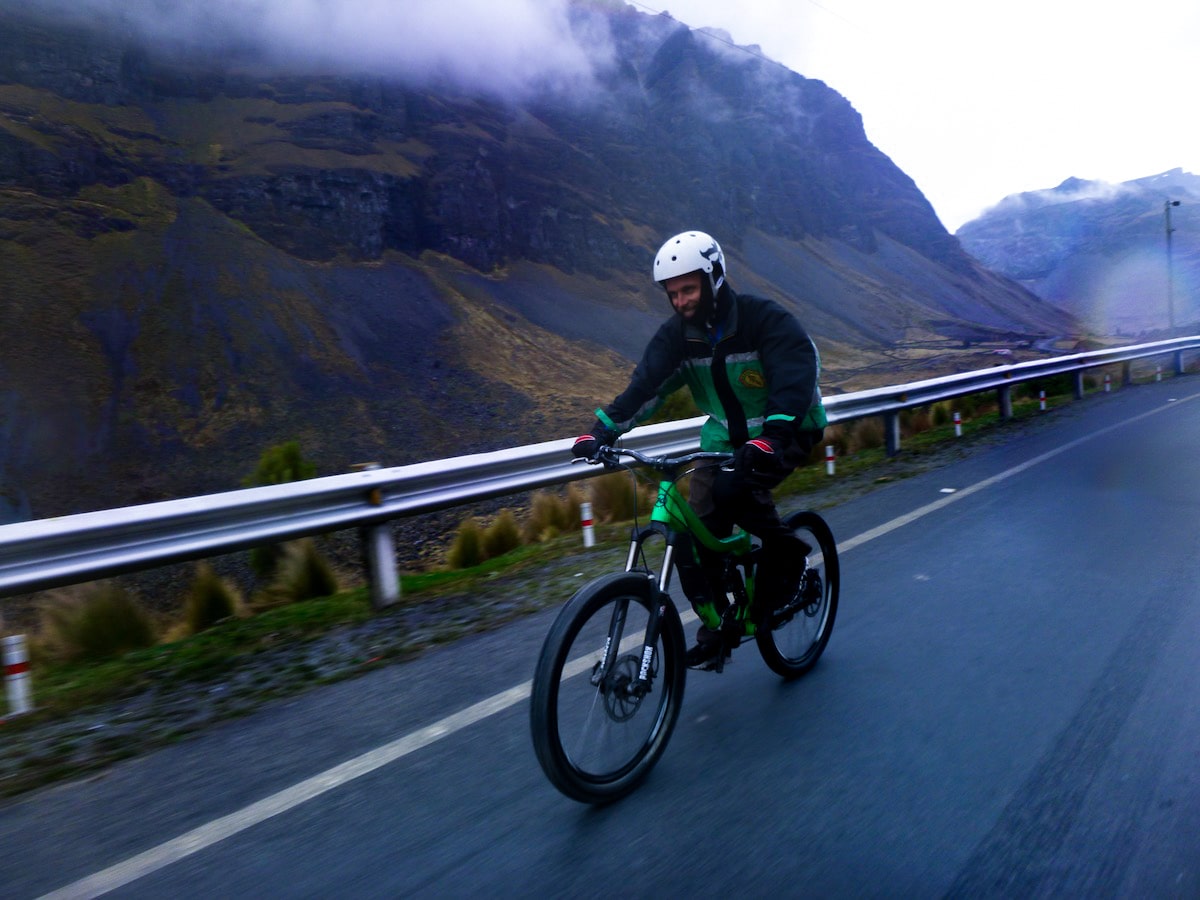
One of the seemingly paradoxical rituals before mountain biking down Bolivia’s Death Road is drinking a shot of pure alcohol before setting off!
While this would go against health and safety standards in most Western nations, this act is actually a beloved local custom. The drink is called “blue cap” and it’s pretty strong stuff, you swig the shot after raising a glass in unison to “Pacha Mama” (Mother Earth) as the pure ethanol burns your throat.
I’m not sure if I fell for the old wive’s tale, but I genuinely feel it relaxed me.
Those who are completely abstinent from alcohol can politely decline to participate in this tradition. There was one lady on our trip who wasn’t keen and the guides were respectful of her wishes.
The guides are Bolivian and Bolivians are largely indigenous and therefore very superstitious. They are also worldly and used to foreigners from different creeds and backgrounds, so there will be no awkward/annoying peer pressure should you wish to reject the offer of a pre-cycle drink and The Mountain Gods will not forsake you.
Oncoming Traffic on The Death Road
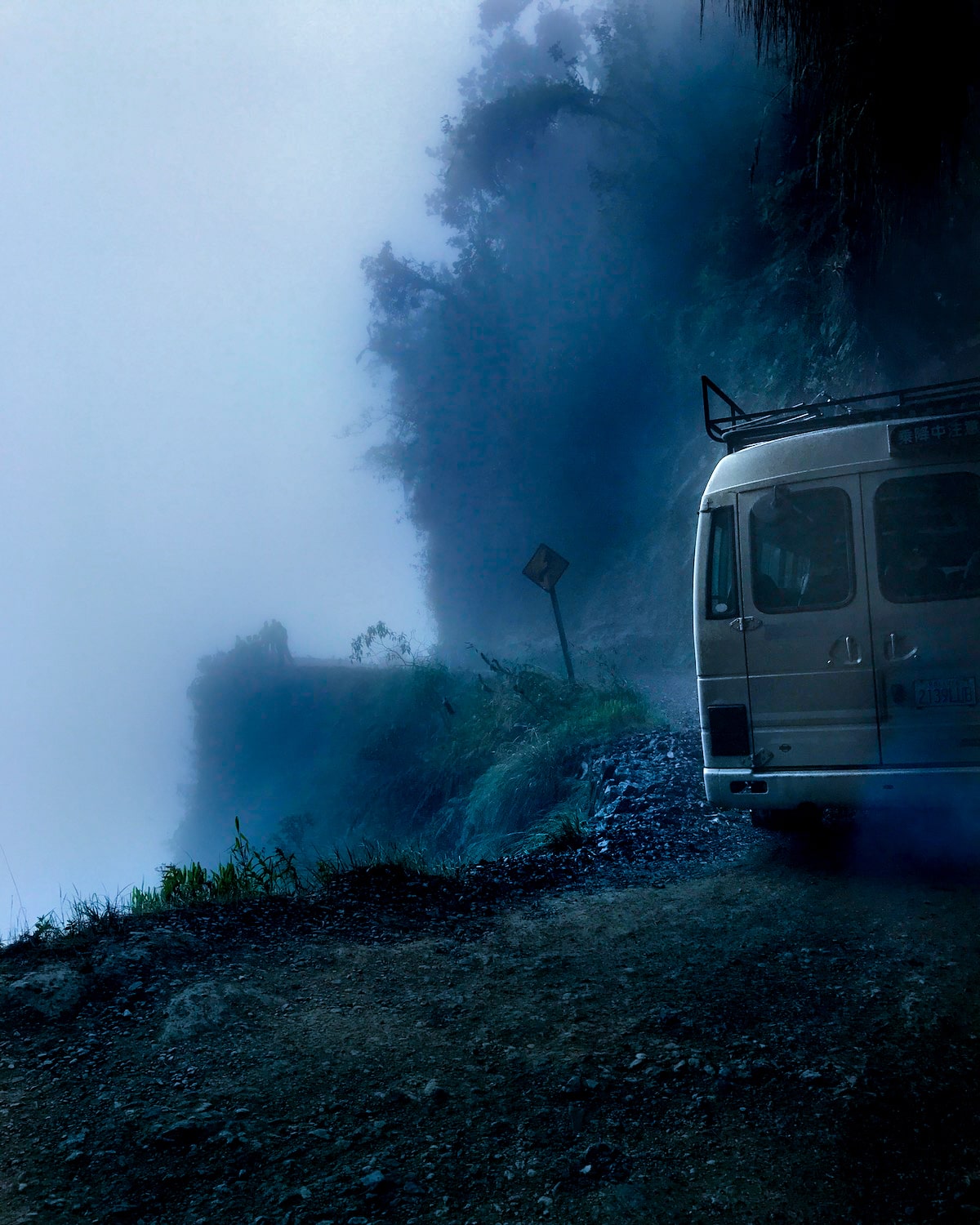
Yungas Road has significantly less traffic from motorised vehicles thanks to the secondary road that was built for vans and lorries, but some bold Bolivians still venture the Death Road and we had to look out for them.
If you decide to cycle down the Death Road in Bolivia, cars, vans and other large vehicles will pass you at some point.
It is much harder and considerably more dangerous for these drivers than it is for you on your mountain bike (check out the above photo with the stomach-churning tight squeeze) so you must give the driver the right of way by moving to the right and stopping until they get past.
We weren’t the only tour on the road and many other cyclists from the other tour companies passed us, most of us were mindful and respectful of each other’s space.
Cursed With Dodgy Weather!
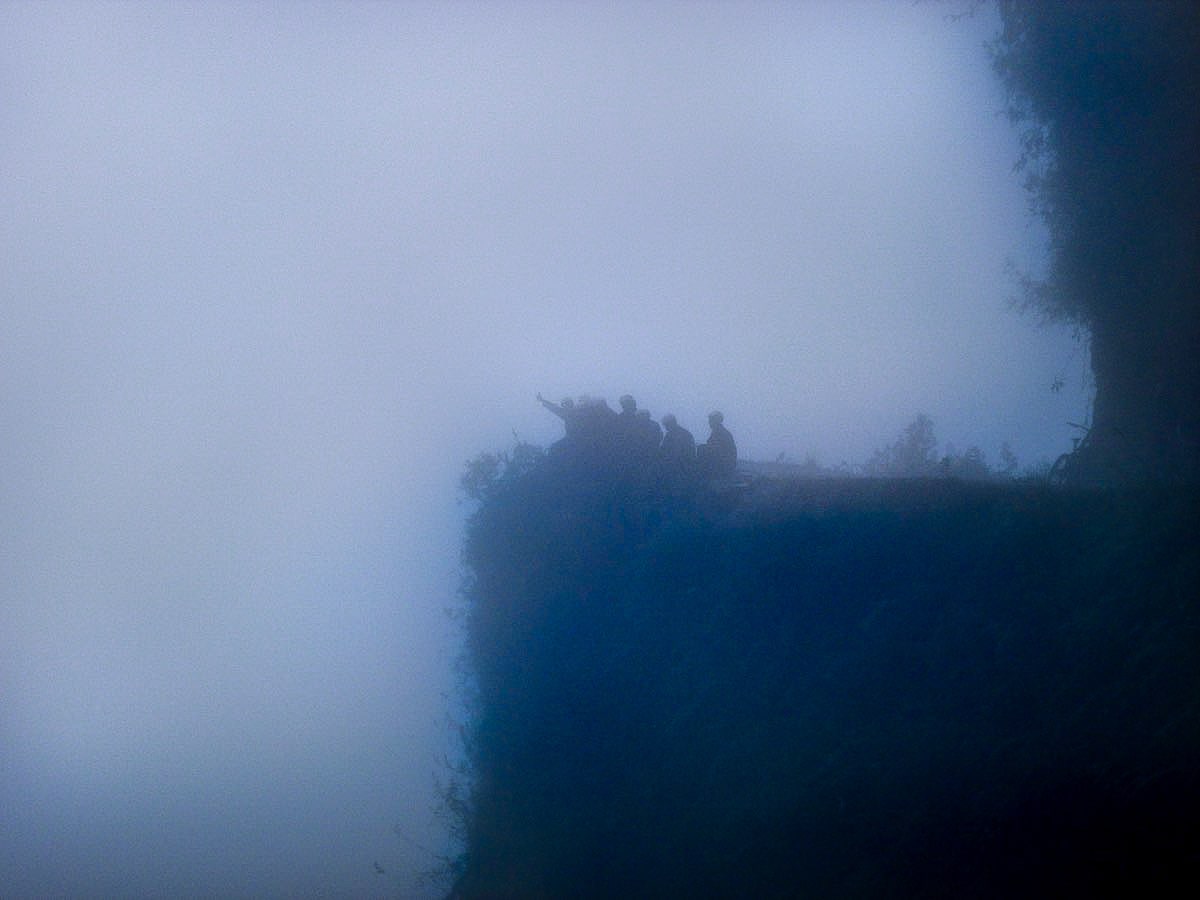
The weather added to our already nervous energy; it was cold and wet and the visibility was awful… absolutely miserable.
The gloomy nature of the environment made the already menacing name of “The Bolivia Death Road” seem even more intimidating.
Landslides are common on the road and we were cycling down the road a few weeks after a big one. The clean-up job is a big one and as the country relies so heavily on the road for tourism, they do the best they can, so it’s not quite optimal and this makes the terrain very slippery.
As the day continued and the lower we got, the fog died out and our vision became clearer. Well, unless you have contact lenses (more on that later!)
Your Tour Guides Will Get All The Cool Photos
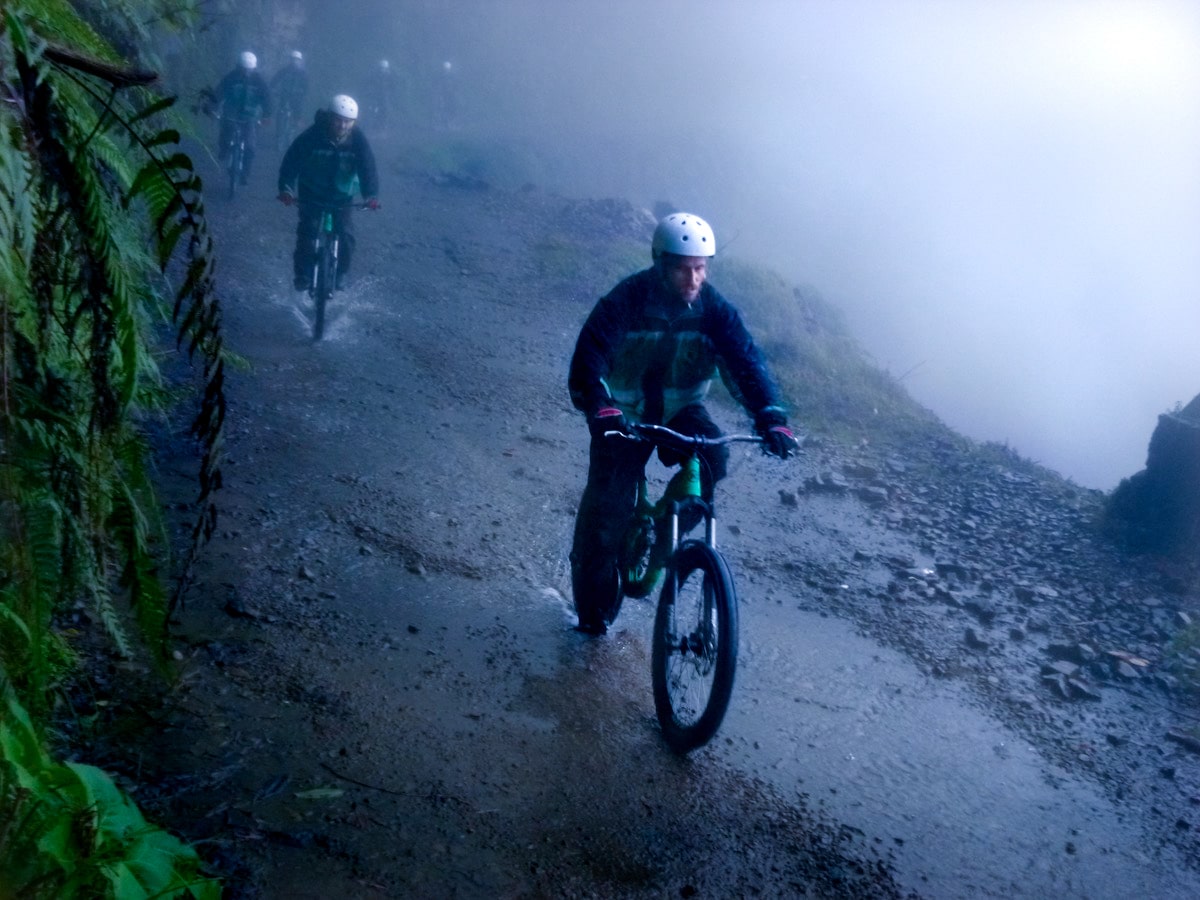
What good is completing a death-defying feat in a foreign country, if you can’t brag to people via social media that you actually did it? If you didn’t capture the moment on Instagram, did it really happen, BRAH?!
Jokes aside, the Bolivian Andes provide stunning landscapes and Insta-worthy photo ops that will tempt you to pull your bike to the side of the road more than once (weather permitting).
One of the last non-Bolivians to die on the Bolivia Death Road, sadly, was a Japanese tourist who was allegedly taking a rolling selfie at the time of death.
The Bolivia Death Road requires a lot of focus. We all want to take photos for souvenirs, luckily for you the tour guides do this every single day and they are experts on how, when and where to take photos.
I am pretty crap at taking enough photos when I travel, luckily for me, I have a plethora of individual and team photos thanks to the safe, smooth systematic guidance of the tour operators’ team members.
Some People Were More Daring (Stupid?) Than Others

Some of us went faster and some of us held back a bit, going at our own pace.
Our guides kept reminding us that this wasn’t the Tour de France, that our safety was the top priority and that we should go at whatever pace we felt suited us and our comfort levels.
A few people (myself included) got a little overconfident in parts, but the Yungas Road humbled us pretty quickly and any near scrapes that occurred made most of us slow down and respect the road.
There were times when I intended to slow down and couldn’t slow down as much as I wanted to due to the slippiness of the ground, a lot of focus and mental energy went into this adventure.
How Scary is Cycling Down The Death Road?

This answer to this question is of course very individual to the individual, their experience and their perception of the encounter on Bolivia’s Death Road.
It wasn’t quite as scary as I first envisaged, but my tolerance level for adventure travel has been raised somewhat since the Macau Tower Bungee Jump (the world’s highest), staying with a tribe in Papua New Guinea and witnessing a voluntary crucifixion in the Philippines.
However, I’m certainly not immune to fear and some things went wrong on the Death Road for me, so it wasn’t completely plain sailing.
You would have to do something very silly or be extremely unlucky to perish on Yungas Road, but it’s still best to exercise caution for you and everyone else on the road.
In terms of fun, for me, it’s right up there with visiting Salar de Uyuni in a two-horse race for the very best things to do in Bolivia, I absolutely loved this experience.
What Went Wrong
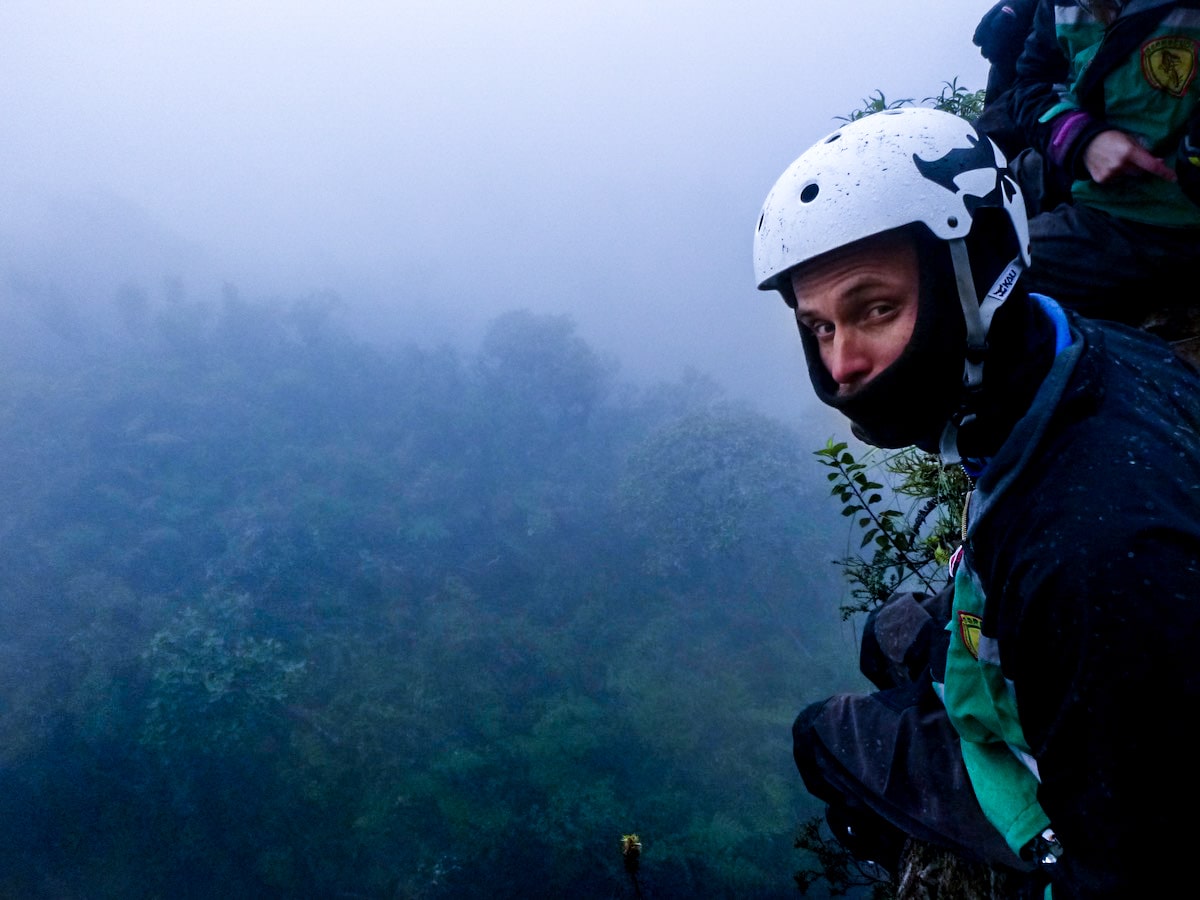
I had a squeaky-bum moment when I pulled my back brake too hard on a tight bend (don’t do that) and my back wheel almost fishtailed off the edge of the cliff.
This was the humbling moment that I referred to earlier. I wasn’t showing off, I just got a little carried away and misjudged the speed and pressure. After this warning from the Mountain Gods, I took a lot more care on wicked bends.
I also lost a contact lens in my eye at one point on a serious decline, which provided somewhat of a sketchy swerve. Rather annoyingly, I had limited vision for the remainder of the tour.
This was the straw that broke the camel’s back towards me getting laser eye surgery a few months after. Absolute game changer.
9 Tips For Surviving Cycling The Death Road in Bolivia
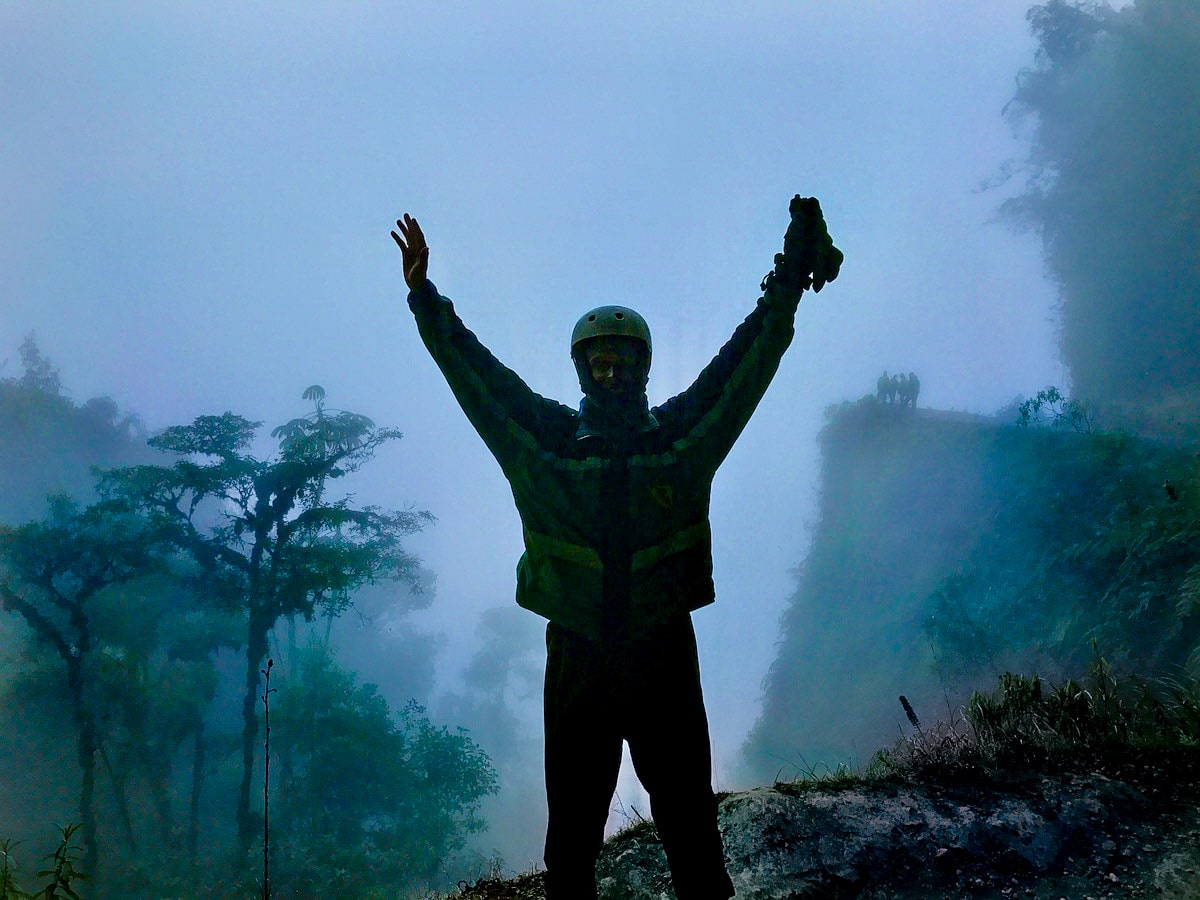
This is the cheat sheet for those who weren’t paying attention or scrolled too fast on this article. I get it, you’re an eager little beaver and you just want to jump onto that saddle and take on the Death Road of Bolivia as soon as possible.
Here’s a reminder about staying safe on the road:
- Don’t scrimp on a tour company. First things first, make sure you go with a reputable tour company. I was over the moon with mine, thanks to their professionalism and the quality of their bikes. Depending on the bike you choose, expect to pay between $80 and $120 for the bike and tour.
- Check your brakes. That aforementioned muscle memory is something that you cannot mess with while on The Death Road. Thinking about which break you need to pull last minute can mean the difference between life and death, or at least a nasty injury. The good news is that the brakes can be configured to your specification, so don’t be shy and make sure you have them set up according to your preference.
- Let traffic pass you. All motorised vehicles get the right of way. If anyone is overtaking you, leave the testosterone for the gym later on and let it be.
- Leave the photos to your tour company. You will get the best of both worlds if you simply enjoy the moment and focus on getting down in one piece. The tour operators really do take excellent photos for your travel memories.
- Don’t drink the night before! A hangover is the last thing you need to burden yourself with on Bolivia’s Death Road. While there are more than enough fun and peculiar things to do in La Paz, they can wait until after you have cycled down Bolivia’s Death Road. Don’t become a grim statistic and save the celebrations until the night of the ride, prioritise a good night’s sleep instead.
- Stick to the left (but not a hard left!) One of the most dangerous aspects of this road is that you need to stick to the left-hand side. This makes passing safer, but it also means you’ll be on the cliffside, which can be precarious at the best of times. Just don’t go too left… it’s a long way down!
- Bring a scarf. It’s bloody windy and cold at the start, God bless my scarf. I’ve finally learned my lesson from not taking one before in similar circumstances when I needed one.
- Wear special contact lenses or glasses. Biking with contacts or glasses is a personal preference for the visually challenged. While contacts can dry out, many cyclists still use them, pairing them with either clear safety glasses or sunglasses. “Extended wear” contact lenses are a great option for long rides, and you should always bring some eye drops just in case, which will help protect your eyes from bugs and things that kick up, such as dirt, dust, and rocks.
- If it’s not for you… that’s perfectly ok. If you feel it’s too intimidating for you, or that you simply won’t enjoy it – there’s nothing wrong with that and you shouldn’t feel as though you have to do it to “conquer your fears” or prove yourself to anyone who you are travelling with.
True friends respect one another’s boundaries.
And from another angle; don’t be selfish. I met a cool and friendly guy on the ride whose girlfriend was absolutely miserable. She was a cloud of negativity, who didn’t want to be there and said from the start that she didn’t really fancy it, but she wanted to tag along for some unknown, mystical reason.
The poor guy became a babysitter while she moped around, scowling all the time and sucking away at his joy. If you’re travelling in La Paz with someone and you don’t think this is for you – put your big boy/girl pants on and let them do their own thing, (my girlfriend at the time didn’t want to come and so she ate chocolate and drank red wine in the hotel bathtub until I came back, hell, I think she had a better time than me!)
Cycling Bolivia’s Death Road: Finding The Right Tour Company

Some people might think you’re crazy committing to cycling down Bolivia’s notorious Death Road, and although they may have a good point, you’d be certifiably insane if you decided to do it with a bunch of cowboys.
Having “died young because s/he tried to save a tenner” on your gravestone is a sad legacy to leave behind.
There are no statues erected for tightarses who ascended to the spirit in the sky because they found a 2-star tour company on the cheap.
Your tour company for Bolivia’s Death Road should have multiple rave reviews for their equipment and competent guides. The big boys on the Bolivian block who tick all of these boxes are:
- Barracuda Biking
- Vertigo Biking
- Gravity Bolivia
Although if you shop around you will see that there are other companies with excellent reviews, I recommend searching for Death Road Mountain Biking Tour options with Get Your Guide and don’t forget the tips above to find a reputable company.
I chose to go with Barracuda Biking (not sponsored) as they satisfied all these requirements and they got back to me faster with my social media messages.
I’ve heard good things about the other two from travellers in Bolivia, but I honestly couldn’t say a bad word about Barracuda. For only $90, they were a perfect tonic of fun, safe, and professional and they made sure everyone thoroughly enjoyed the experience.
Now you know all the ins and outs of tackling Yungas Road via mountain bike.
So hold on tight and focus hard for about 3-4 hours, and you will get to humblebrag that you once cycled down Bolivia’s Death Road, the next time it gets featured in a documentary.
Just make sure that living to tell the story is your main priority. Have fun!
Looking for adventure in South America?
- Learn How To Live it up in Lapa, Rio de Janeiro
- 3 Weeks Patagonia Itinerary For Argentina and Chile
- The Ultimate Guide To Visiting Both Sides of Iguazu Falls
- How To Buy Boca Juniors Tickets As A Tourist in Argentina
- Read about my (first) Aconcagua Failure
- How Hard is it To Climb Aconcagua?
- Don’t forget your insurance! Read my SafetyWing Travel Insurance Review
- My Favourite Travel Gear From 10 Years on The Road

